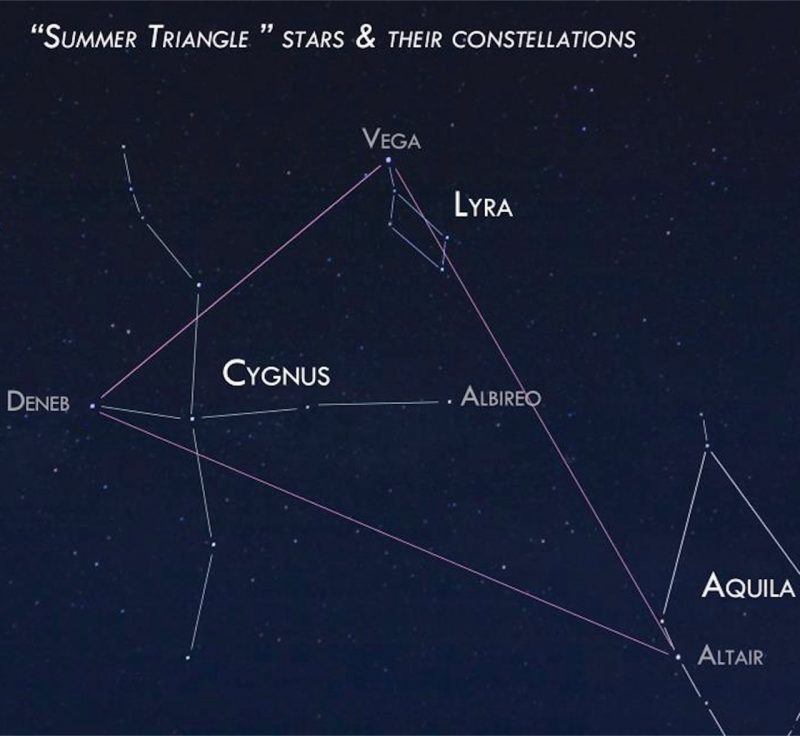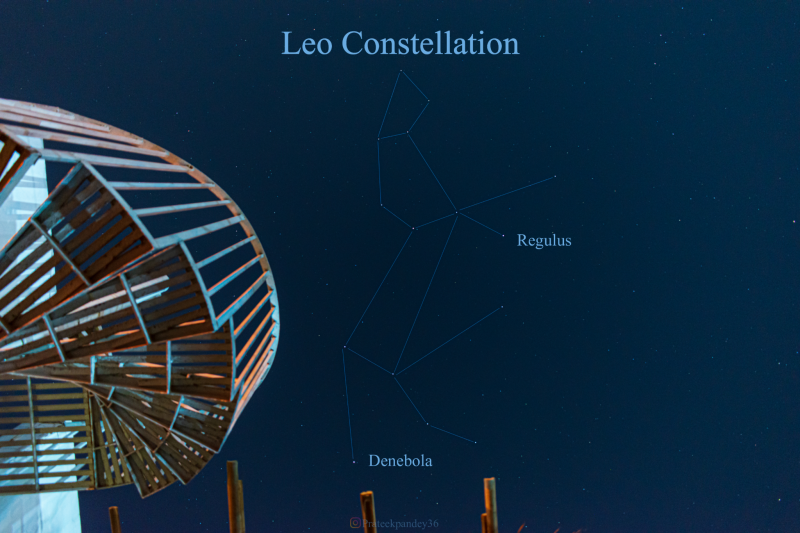
A constellation is an official group of stars. An asterism is an obvious pattern or group of stars with a popular name.
Is it a constellation or an asterism?
A constellation is a pattern of stars in the night sky. The word is from the Latin constellacio, meaning a set of stars. There are 88 official constellations, all with well defined boundaries. Many constellations are very old. They are a link between us and our ancestors, a projection of human imagination into the cosmos. Ancient people looked at the stars and thought they saw mythical beings, beasts and cultural touchstones among the stars.
On the other hand, most asterisms are relatively new. Many are small patterns within a constellation, and some are large patterns made of bright stars from multiple constellations. There is nothing official about an asterism, but many are well known. Generally an asterism is a simple pattern that is easy to recognize.
Some well known asterisms
The Plough, for example, (also known as the Big Dipper) is a pattern of seven stars within the constellation of Ursa Major, the Great Bear. It is undoubtedly the most famous asterism in the sky, and not just because it is useful as a guide to other stars and constellations.
In the southern hemisphere, five stars comprise the Southern Cross, an asterism within the constellation of Crux.
Sometimes, asterisms contain stars from more than one constellation: for example, the glorious Summer Triangle, is a very prominent in the northern hemisphere. It is made from the 3 brightest stars of Cygnus, Lyra and Aquila. In Sagittarius there is the famous “teapot” asterism, which points toward the center of our Milky Way galaxy. Pleiades is a popular asterism in Taurus; it is a lovely naked eye cluster of stars.
A closer look at constellations
All the stars in constellation lie at different distances from the Earth. For example, the three stars comprising the constellation of Triangulum are between 35 and 127 light years away.
While a constellation looks like its stars are the same distance away, in reality that is only because stars vary in size and brightness. Generally, when two stars appear to be the same magnitude in the sky they are actually many light years apart. Thus an alien astronomer on a planet 100 light-years from Earth knows very different constellations, because they see the night sky from a completely different perspective.
Many constellations are well-known: such as Orion, Ursa Major, Cassiopeia, Cygnus. These are some of the famous star patterns you first learn when you begin stargazing.

Constellations of the Zodiac
Maybe the most popular constellations are those of the zodiac, such as Aries, Libra, Pisces, Virgo plus the 8 others.
It was more than 2,000 years ago that the Babylonians drew the first astrological charts with the 12 zodiacal constellations. (Although the history of the zodiac probably goes back further). The 12 constellations of the zodiac determine your sign based on when the sun is in your astrological constellation, based on the sun’s location 2,000 years ago. Two thousand years later, the sun is no longer located in those astrological signs.
First, astrology divides the 360-degree zodiac into 12 equal segments, without regard for how many degrees each constellation actually covers in the sky. Second, the Earth is titled on its axis, causing an effect known as the precession of the equinoxes. This results in the equinoxes moving westward relative to the fixed stars.
Astronomically, the sun passes through a 13th constellation of the zodiac: that of Ophiuchus, the serpent-bearer. This results in changing the dates when the sun “passes through” each zodiacal constellation. So for example, Aquarius largely occupies the space where Pisces resides. Therefore, this invalidates the dates of the astrological star-signs of horoscopes, as well as the dates of the supposed star sign which people are “born under”.
History of constellation and star names
The Greeks and Romans first recognized and named the constellations of the Northern Hemisphere – around the second century A.D. – although doubtless prehistoric humans created their own constellations. Indeed, every culture sees its own mythology and stories in the stars. Not surprisingly, the Greeks and Romans saw their mythological heroes, heroines and beasts in the sky: such as Pegasus, Orion, Taurus, Cassiopeia and many others.
The first known list of constellations appears in Ptolemy’s 2nd-century Almagest, covering the apparent motions of stars and planets. It also established a geocentric view of the universe that was to persist for 1,200 years. While the Greeks and Romans bequeathed us the names of the Northern Hemisphere constellations, it was Arabs who were the first to name the individual stars.
Islamic scholars were the first to systematically map the skies. Many of these Arabic star names have survived until today: Aldebaran, Alcor, Altair, Algol. The prefix “Al-” is a sure indication of an Islamic name: It simply means “the.” Hence, Aldebaran is “the follower,” because it appears to follow the Hyades star cluster that makes up the head of the constellation of Taurus the Bull.
Making constellations official
The International Astronomical Union formally recognized the 48 constellations of the Northern Hemisphere, and their boundaries, in 1928. They published an official list in 1930. The naming of the constellations of the Southern Hemisphere, however, is a little more complicated.
Italian, Dutch and Portuguese explorers of the 14th to 16th centuries named many of the constellations in the Southern Hemisphere. So southern constellations are objects and beasts associated with the great seafaring voyages of that epoch: Telescopium, the telescope; Octans, the octant; Dorado, the swordfish; Vela, the ship’s sails; Hydrus, the sea serpent. But explorers and observers often proposed different constellations with conflicting names. The current list of southern constellations became official in the 19th century.

When a constellation marks a seasonal change
Certain constellations have acquired special significance over the millennia because of their appearance marking the onset of seasons. Stars or constellations told ancient peoples when to sow or reap their crops, when to collect food or animal skins. Because of the Earth’s orbit around the sun, different constellations become visible at different times of the year.
For example, in the Northern Hemisphere, the appearance of Orion in the early morning sky warns of the onset of autumn and that temperatures will shortly start to drop. The rising of the Summer Triangle to prominence in the northern sky is a harbinger of summer. Thus, to ancient cultures, constellations were more than just patterns: they marked the passing of the seasons, of years, of life itself.
A circumpolar constellation stays above the horizon
From an observer’s perspective, from sunset to dawn the sky appears to revolve around one fixed point in the sky. This location in the heavens is what the Earth’s axis points at: the celestial pole.
In the Northern Hemisphere, Polaris (the pole star) lies very close to the celestial pole. The Southern Hemisphere does not have a bright star marking that location. The constellations that revolve around the celestial pole but do not dip below the horizon during the night and are circumpolar constellations. In other words, for an observer these constellations will never set. Your location on Earth determines which constellations are circumpolar.
There are five major circumpolar constellations in the Northern Hemisphere: Ursa Major, Ursa Minor, Draco, Cassiopeia and Cepheus. The Southern Hemisphere has three: Crux, Centaurus and Carina.
Learning to identify constellations
A budding astronomer can easily learn the constellations. Start by finding the brighter stars and constellations, and remember, it does take practice! There are many excellent resources and planetarium-type programs available free online. It is certainly worth learning the constellations, even if we sometimes strain to see what the ancients did.
Bottom line: Constellations and asterisms are patterns of stars. Some asterisms consist of stars from different constellations, and some asterisms are part of one constellation.
The post What’s a constellation? What’s an asterism? first appeared on EarthSky.
0 Commentaires